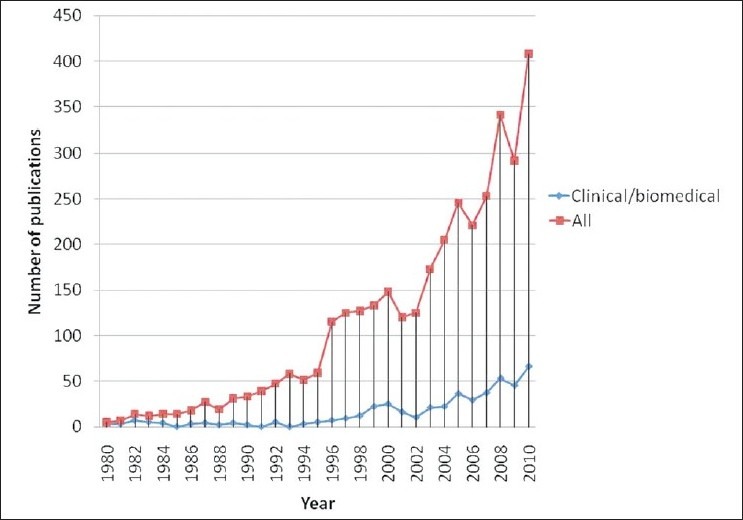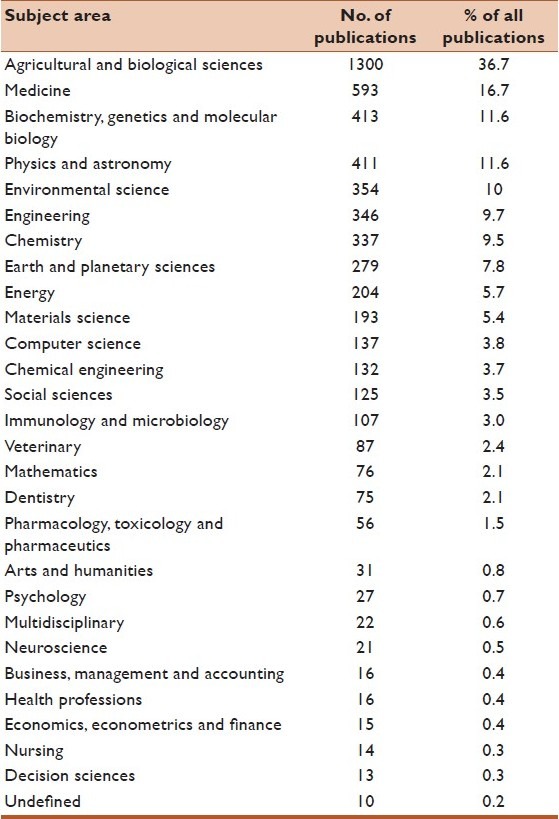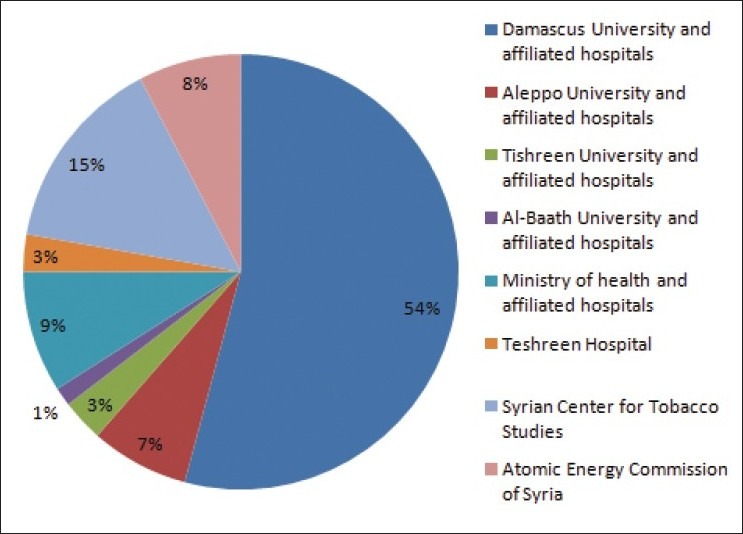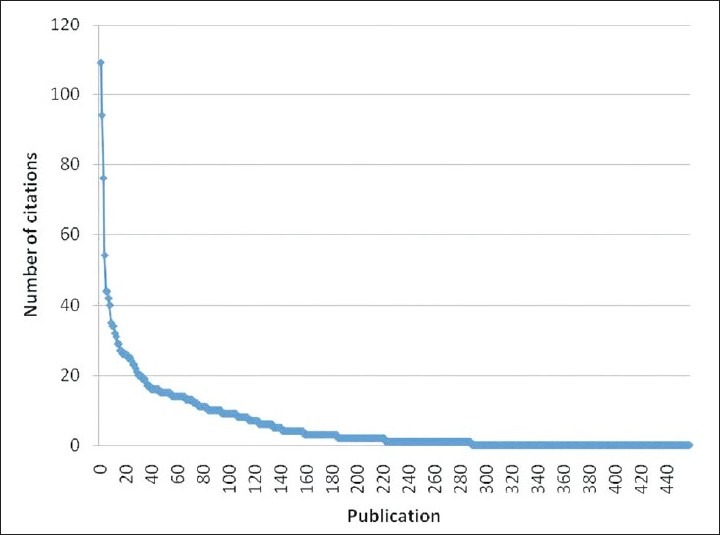Abstract
Context:
Scientific research output measured by the number and quality of publications reflects the research productivity of a certain community.
Aims:
To examine the quantity and quality of research produced by Syrian institutions with particular emphasis on the clinical and biomedical research.
Settings and Design:
Retrospective observational analysis of research originating from Syrian institutions indexed by Medline and Science Citation Index (SciVerse) Scopus bibliographic databases.
Materials and Methods:
Comprehensive review of the literature indexed by Medline and SciVerse was conducted including data from Jan 01, 1980 till February 2011 searching for authors affiliated with Syrian institutions. Clinical and biomedical research data were further analyzed quantitatively and qualitatively.
Results:
The total of manuscripts indexed by SciVerse originating from Syrian institutions during the last 3 decades is 3540. A total of 458 publications cover clinical and biomedical subject areas. The quality of these 458 publications was evaluated by the citation frequency and impact factor of publishing journals with h-index of 24.
Conclusions:
Although the spectrum of research originating from Syrian institutions is broad, the overall number of publications particularly in clinical and biomedical subjects is minuscule and of limited quality. The presented data indicate the need to promote research capabilities and to bridge the gap in research productivity by Syrian institutions.
Keywords: Bibliographic databases, research, Syria
INTRODUCTION
Evidence-based practice is deeply rooted and well established in the fields of medicine since its early days. Documenting clinical observations, treatment strategies including pharmacologic and surgical interventions and subsequent outcomes by preceding clinicians helped in establishing a core for safer clinical practice and development of basic biomedical research activities. This was supported by the tremendous expansion of clinical and biomedical literature in the last century and further facilitated by the recent internet and technology revolution, which allowed easy worldwide access to medical literature by practicing physician and researchers. As the number of medical publications parallels research activities, the degree of contribution of medical societies to the literature is regarded as a marker of clinical performance and research productivity. Several factors may contribute to the unequal scientific output of certain medical communities. However, the need to bridge these gaps, particularly in the field of medicine, is inevitably recommended for safer practice of medicine. In this study, we analyze the existing literature produced by researchers from the Syrian Arab Republic in all fields and further dissect the clinical and biomedical research output over the past 3 decades.
MATERIALS AND METHODS
Comprehensive online search was performed in the Science Citation Index (SciVerse® Scopus) (Elsevier B.V., Amsterdam, The Netherlands) accessible at www.scopus.com, which is one of the world's largest abstract and citation databases of peer-reviewed literature which contains 41 million records and covers nearly 18,000 titles from 5000 publishers worldwide and provides 100% Medline coverage.[1] The search was done in February 2011 using the keywords of (Syria OR “Syrian Arab Republic” OR Syrian) limiting the search fields to (Affiliation) and date range from January 1980 till February 2011. The “affiliation” field includes the institutions of authors in any rank and not necessarily the first or the corresponding author. Similar search using same keywords and limits was conducted using PubMed, the online gate to the archives of the National Library of Medicine (NLM) in the United States of America accessible at (http://www.ncbi.nlm.nih.gov/pubmed/), which comprises more than 20 million citations for biomedical literature from MEDLINE, life science journals, and online books. Data regarding number of publications per year of publication, subject area, affiliation, language, document, and source type was extracted. The SciVerse Scopus search was then limited using automated functions to include fields of medicine, nursing, and health professions excluding biochemistry, genetics, and molecular biology, immunology and microbiology, pharmacology, toxicology and pharmaceutics, psychology, and neuroscience. Irrelevant subject areas, including dentistry, radiation, engineering, mathematics, business, economy, agriculture, and others, were also excluded from the search. The results were then screened for duplicates and for institutions with names that included the keyword “Syrian” but not located in Syria, such as the Syrian–Lebanese hospital in Brazil. The latter search results were analyzed using the website's automatic function to assess the quality of publications. Citations received since 1996 as documented by the SciVerse scopus were recorded with and without self-citations by all authors. The h-Index calculated for the collected data and the h-graph was generated. The h-Index represents the number citations received for each of the articles in descending order and the h-graph measures the impact of a set of documents and displays the number of citations per article. Next, the journal's impact factor was evaluated using the Journal Citation Report® (JCR) 2009 science edition by Thomson Reuters (New York, NY, USA).
RESULTS
The total number of manuscripts originating from Syrian institutions from 1980 till February 2011 was 3540. Of these documents, only 468 were indexed by PubMed search in the archives of the National Library of Medicine (NLM). The annual distribution of the documents identified by SciVerse [Figure 1] shows the trends for all research fields compared to the clinical and biomedical research. The number and percentile distribution of the publication per subject area is shown in Table 1. Agricultural institutions contribute the highest number of publications to the scientific output from Syrian institutions followed by the fields of medicine, biochemistry, genetics, and molecular biology. Limiting the search to clinical and biomedical subjects as detailed in the methods section yielded a total of 458 publications distributed between institutions as illustrated by Figure 2. Of the main institutions, Damascus University and its affiliated hospitals generated 156 papers, which constitute 54% of the clinical and biomedical research followed by the Syrian Center for Tobacco Studies (15%) and the Ministry of Health and it affiliated hospitals (9%). When taking into consideration the age of the institution, the Syrian Center for Tobacco Studies, which was established in 2002, becomes the leading institution in research with annual average of 5 publications per year. The majority of these papers are published in English (n=428). The document type is mainly article type (n=351) and reviews (n=40). Of these 458 clinical and biomedical documents, the total number of citations received after 1996 was 2597 with h-index of 24, which indicates that 24 documents have been cited at least 24 times, including self-citations by all authors. When self-citations are excluded, the total number of citations received after 1996 was 2227 with h-index of 22 that indicates that 22 documents have been cited at least 22 times [Figure 3]. The journal with the highest impact factor is Lancet (JCR = 30.7). The remaining Journals, the Syrian author's rank and the type of publication are illustrated in Table 2.
Figure 1.

The annual distribution of overall and biomedical research produced by Syrian institutions. A positive trend is observed since 1980
Table 1.
Number of publications originating form Syrian institutions per subject area

Figure 2.

Pie chart illustrating the percentage of biomedical publications produced by individual institution
Figure 3.

The h-graph of the 458 biomedical publications, which illustrates the relationship between publications and citation frequency, including self-citations
Table 2.
Number of clinical and biomedical publications in top 10 ranked journals

DISCUSSION
Although the contribution of the Arab countries to the unbounded scientific literature is gradually increasing over the last few decades, the number of clinical and biomedical publications remains minuscule. The advent of internet and online bibliographic databases has not only allowed easy accessibility to medical literature, but also offered a useful tool for objective quantitative and qualitative analysis and monitoring of trends in the number of publications based on regional and institutional distribution. Several recent bibliometric studies assessed research outputs in different Arab countries and compared their productivity to other neighboring countries.[2–9] It is observed that there is unequal distribution of research activities in the Arab world. For example, Kingdom of Saudi Arabia and Egypt produce almost 60% of the research generated by the Arab world.[3,7] Benamer et al. indicated a negative trend in biomedical research generated by Libyan medical schools and professionals.[4,5] Moreover, it was shown that the contribution of the Arab world to the biomedical literature is of limited quality as well as quantity.[3,7,8] In a recent survey of the publications originating from Syrian institutions indexed by Medline and Embase databases, productivity of publications was gradually increasing from 1979 till 2006 by 1.4 article/year.[7] In our analysis which includes data indexed in the SCI database, the total number of publications over the past 3 decades in all fields remains exceedingly low despite the positive trend particularly in the field of clinical and biomedical research. Syrian researchers produce far less publications in comparison to neighboring Arab and non-Arab countries in the Middle East.[3,8] Furthermore, the quality of reported publications is low as indicated by the type of publications,[7] citation frequency, and publishing journals’ impact factors. These findings unveil the need to improve the research environment. Several measures can be implemented to improve scientific output and bridge the gaps in research productivity:
Increasing literature accessibility via a more comprehensive search engines. A noticeable proportion of studies originating from Syria were not indexed in PubMed, the main free search engine for medical literature. Journals with subscription further limit access and may preclude local clinicians and researchers from utilizing locally produced data in developing clinical decisions. The Hinari initiative by the World Health Organization (WHO; http://www.who.int/hinari/en/) is a program that enables developing countries to gain access to the world's largest collections of biomedical and health literature. The number of Syrian institutions participating in this program remains limited to 12 institutions as of February 2011. The list of these institutions can be accessed at http://extranet.who.int/hinari/en/browse_institutions.php?cntry=99. Awareness of this initiative may provide broader coverage of medical sectors. Publishing in open access journals may expand the local audience from Syrian health care providers. The increasing role of open access journals has a positive impact on the availability of scientific journal literature.[10]
Although the role of international collaborative research is evident from the collected data, further regional and international collaboration and engagement of expatriate scholars will enhance the research environment.
Establishing institutional journals indexed by the major bibliographic databases may facilitate publication by Syrian professionals and increase the visibility of their research.
As the majority of medical literature is in English, improving language and editorial skills may be required and additional steps, such as incorporating research requirements in curricula, may be helpful.
In conclusion, the present data indicates gradual expansion in scientific output by Syrian institution. However, it points out to the need for collective efforts by the scientific and medical community to further strengthen research productivity and bridge the existing gap.
Footnotes
Source of Support: Nil
Conflict of Interest: None declared.
REFERENCES
- 1.SciVerse Scopus fact sheet. SciVerse® Scopus, Elsevier B.V., Amsterdam, Netherlands. [Last accessed on 2011 Feb 19]. Available from: http://www.info.sciverse.com/UserFiles/2508.SciVerse.Scopus_Facts_Figures%28LR%29.pdf .
- 2.El Ansari W, Afifi Soweid RA, Jabbour S. Geography of biomedical publications. Lancet. 2004;363:489. doi: 10.1016/S0140-6736(04)15498-6. [DOI] [PubMed] [Google Scholar]
- 3.Benamer HT, Bakoush O. Arab nations lagging behind other Middle Eastern countries in biomedical research: A comparative study. BMC Med Res Methodol. 2009;9:26. doi: 10.1186/1471-2288-9-26. [DOI] [PMC free article] [PubMed] [Google Scholar]
- 4.Benamer HT, Bredan A, Bakoush O. A negative trend of biomedical research in Libya: A bibliometric study. Health Info Libr J. 2009;26:240–5. doi: 10.1111/j.1471-1842.2008.00792.x. [DOI] [PubMed] [Google Scholar]
- 5.Benamer HT, Bredan A, Bakoush O. Scientific publication productivity of Libyan medical schools: A bibliometric study of papers listed in PubMed, 1988-2007. Educ Health (Abingdon) 2009;22:310. [PubMed] [Google Scholar]
- 6.Bissar-Tadmouri N, Tadmouri GO. Bibliometric analyses of biomedical research outputs in Lebanon and the United Arab Emirates (1988-2007) Saudi Med J. 2009;30:130–9. [PubMed] [Google Scholar]
- 7.Matar HE, Almerie MQ, Adams CE, Essali A. Publications indexed in Medline and Embase originating from the Syrian Arab Republic: A survey. East Mediterr Health J. 2009;15:648–52. [PubMed] [Google Scholar]
- 8.Shaban SF, Abu-Zidan FM. A quantitative analysis of medical publications from Arab countries. Saudi Med J. 2003;24:294–6. [PubMed] [Google Scholar]
- 9.Tadmouri GO. Biomedical science journals in the Arab world. Saudi Med J. 2004;25:1331–6. [PubMed] [Google Scholar]
- 10.Bjork BC, Welling P, Laakso M, Majlender P, Hedlund T, Gudnason G. Open access to the scientific journal literature: Situation 2009. PLoS One. 2010;5:e11273. doi: 10.1371/journal.pone.0011273. [DOI] [PMC free article] [PubMed] [Google Scholar]


